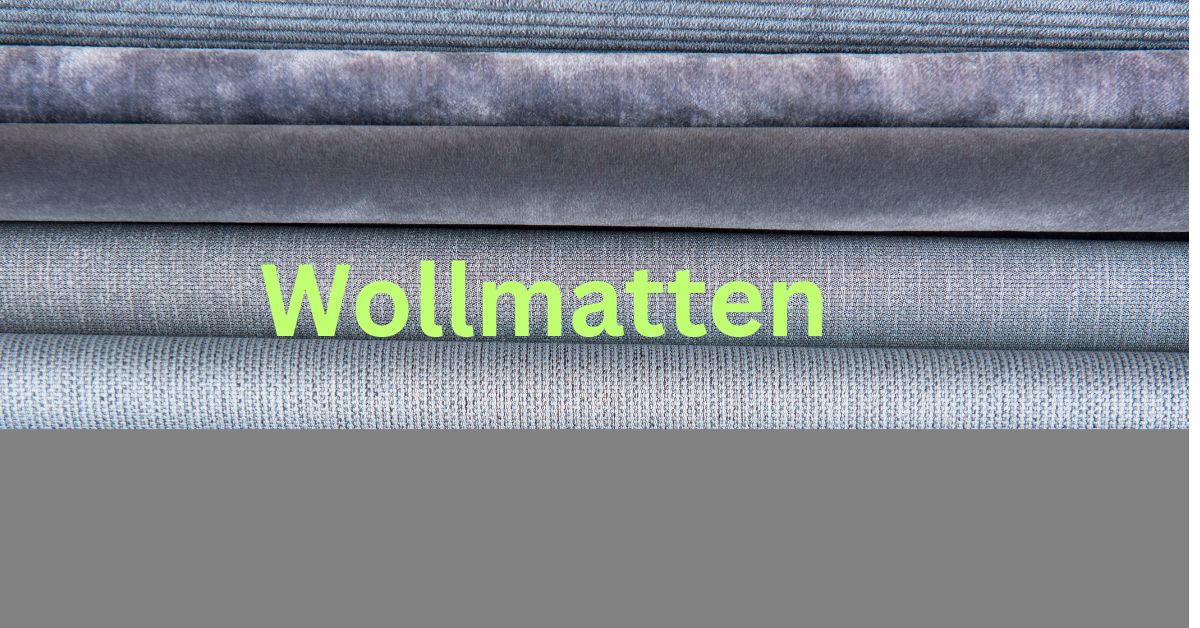Fashion
Wollmatten: A Comprehensive Study of Traditional Wool Mats and Their Modern Relevance

Wollmatten are textiles made primarily of wool that blend utility, comfort, and tradition. In this article one will explore their origins, materials, manufacture, advantages, care, and varied uses, with a factual and balanced perspective rather than a promotional view wollmatten. The goal is to understand what makes them special, how they perform compared to alternatives, and what to consider if one wishes to have one. The word will appear at a frequency of roughly 1.5 % over the whole article.
Table: Key Attributes of Wollmatten
| Attribute | Description |
|---|---|
| Material Composition | Mostly sheep’s wool, sometimes blended with other natural fibres (goat, alpaca), occasionally mixed with synthetic reinforcements depending on application. |
| Manufacture Techniques | Felting, weaving, pressing (fulling), or combinations of these. Some mats are hand‑made, others machine‑produced. |
| Physical Properties | Insulating (thermal), moisture‑regulating, durable under foot traffic, sound absorbing, resistant to odours, biodegradable. |
| Typical Uses | Floor coverings, area rugs, wall hangings, seating pads, outdoor‑protected settings, historic or artisan décor. |
| Maintenance | Regular gentle vacuuming or shaking, spot cleaning with mild or wool‑safe detergents, occasional airing, protecting from prolonged direct sun exposure. |
| Wollmatten Environmental & Health Aspects | Renewable material, less chemical processing than synthetics, biodegradable, naturally flame‑retardant, tends to be more breathable than many artificial mats. |
Historical and Cultural Background Wollmatten
Wool has been used by humans for millennia, first very simply as clothing, blankets, and basic coverings. Over time techniques of weaving, felting, and later fulling (a process to thicken and bind woven wool) were developed in many regions. In nomadic or pastoral societies, wool matting or felted wool pieces served as ground coverings or insulation in tents and yurts. In more settled cultures, woven wool mats or rugs became decorative and status objects as well as practical ones.
In Europe during the Middle Ages wool was an important textile, both for clothing and for floor coverings. Artisans wove patterned rugs or mats; trade in wool and woollen goods was a major component of many regional economies. The industrial revolution introduced mechanised weaving and treatment of wool, which made wool mats more accessible to people beyond the artisan‑class. Even today many of the traditional techniques persist and are valued for their craft quality.
Materials and Manufacture
Wool Types and Sources Wollmatten
Wool from sheep is the most common. Certain breeds (for example merino, or local hardy sheep in mountainous areas) produce wool with different fineness, crimp, and durability. Sometimes other animal fibers (goat, alpaca) are used either for blending or added texture. The purity of wool, the way it is washed (or whether raw wool is used), and how much lanolin or natural oils remain also affect its performance.
Techniques
Felting: Wool fibers are agitated with moisture, heat, and pressure until they mat together. Felted mats tend to be dense, somewhat stiff, good for insulation or protective pads.
Weaving: Fibres/yarns are woven on looms. Weavings may be flat‑woven (no pile) or have pile (loops or cut pile). The weave pattern, thread count, and thickness affect softness, resilience, and durability.
Pressing/Fulling: After weaving, wool cloth can be processed (washed, agitated, pressed) to cause fibers to felt slightly and the weave to tighten. This reduces gaps, increases insulation and durability.
Finishing: Dyeing (natural or synthetic dyes), trimming edges, adding backing or reinforcement (for outdoor or heavy use), sometimes adding non‑slip or waterproof layers (though adding synthetic or treatment elements may impact biodegradability).
Physical Properties and Performance
Wool naturally has several useful physical properties. It is a good thermal insulator: it traps air in its structure, helping to keep spaces warm in colder weather and, in some cases, moderating heat in warmer times. It also has a natural ability to absorb moisture (humidity or spilt liquids) without feeling soggy, and then release it, which helps reduce dampness and mould risk. Because of its dense fiber structure, it is reasonably durable under foot traffic, resistant to crushing more than many synthetic fibres. Wool also has some natural resistance to fire, due to its content and structure. Its fibres are biodegradable, meaning at end of life they return to the environment more benignly than many plastics. However wool is heavier, needs more careful care, and sometimes costs more than mass‐produced synthetic mats.
Comparison with Alternatives Wollmatten
When compared to mats made of synthetics, cotton, jute, or poly blends, some trade‑offs emerge. Synthetic mats are often cheaper, lighter, easier to wash aggressively, and more uniform in appearance. Cotton ones are breathable and soft but less durable, tend to stain or wear out sooner. Natural fibres like jute or sisal are strong and cheap but less soft and more coarse underfoot; they do not insulate as well and may degrade faster. Wollmatten sit relatively high on the scale of insulation, comfort, longevity, and environmental friendliness, at the cost of sometimes requiring more careful cleaning and being heavier or more expensive.
Advantages of Wollmatten
Some of the most significant advantages include:
Natural Insulation: They moderate temperature and help retain heat. This is particularly useful in cold floors or in regions with marked seasonal variation.
Comfort underfoot: The softness and “cushioning” effect of fibers make walking or standing on them more comfortable than hard surfaces alone.
Noise Reduction: Dense wool mats help absorb sound; footsteps or echoes in rooms are muted more than with hard flooring. This contributes to more peaceful indoor environments.
Moisture and Odour Management: Wool fibres can absorb moisture; also, because wool contains natural compounds (like lanolin), it tends to resist odours and microbial growth better than some materials.
Environmental Benefits: Renewable resource, less reliance on synthetic chemicals if natural dyes are used, biodegradable, often produced in regions with wool farming. The carbon footprint can be lower than synthetic mats especially if local.
Long Lifespan: If well made and cared for, they can last many years, often longer than similar synthetics, which degrade, flatten, or lose appearance more rapidly.
Drawbacks and Considerations
While many aspects are positive, there are some limitations or considerations:
Cost: High quality wool mats cost more to produce and buy than many mass‑market synthetics. The craftsmanship, wool quality, dyeing, etc. factor in.
Weight and Bulk: They can be heavier, thicker, bulkier to move, store, or clean.
Cleaning Sensitivity: Washing must often be gentle; high heat, rough agitation, or harsh chemicals may damage fibres, cause shrinkage, fading of dyes, or impair insulating/soft qualities.
Wear in High‑Traffic Zones: Even though durable, in very high traffic or heavy duty settings (e.g. outdoors, entryways with many shoe traffic), wool mats may wear faster or lose their shape unless reinforced or backed appropriately.
Climate Suitability: In very humid or very damp conditions prolonged moisture exposure may lead to issues unless the mat is allowed to dry well; also direct sun exposure can fade colours or degrade fibres over time.
Allergy Concerns: While many people tolerate wool well, those with wool allergies or very sensitive skin may find contact irritating; also dust or fibers may trigger irritation if not cleaned regularly.
Care and Maintenance Wollmatten
Good care can extend lifes Wollmattenpan and preserve appearance. Here are guidelines grounded in practice and research.
First, regular cleaning: shaking out dust or debris, vacuuming with a vacuum cleaner suited for wool (gentle suction, no beater bar or with settings to avoid fibre damage). Clean both top and underside if possible.
Second, deal with spills promptly: blot (don’t rub) liquid spills with an absorbent cloth. Use mild wool detergent or a soap safe for wool. Cold or lukewarm water is preferred. Avoid soaking or harsh mechanical action.
Third, periodic airing: putting the mat out in fresh air helps remove odours and moisture. Avoid strong direct sun for long periods to prevent fading or weakening.
Fourth, rotate the mat occasionally to distribute wear evenly, especially in areas where foot traffic is heavier.
Fifth, avoid overly wetting or exposing to standing water; if a wool mat gets wet (e.g. due to rain or spills), dry thoroughly to avoid mildew or structural damage.
Practical Uses Wollmatten
Wollmatten are adaptable. They may be used as area floor coverings in living rooms, bedrooms, hallways. They can be placed under furniture to provide insulation and buffer noise. In more artisanal settings they serve as accent pieces—wall hangings, seating cushions or mats for meditation or yoga, or decorative rugs. They are also used outdoors in semi‐protected areas (porches, covered patios) if treated or reinforced. In historical or rustic architecture, they match well in cabins, barns, or homes that value natural materials. Furthermore in places with cold floors (stone, tile), wool mats help in making interiors more comfortable underfoot. In places with seasonal climates they help reduce heating costs by reducing heat loss through floors.
Environmental and Sustainability Aspects Wollmatten
From a lifecycle perspective, wool is renewable: sheep are shorn annually, and the wool grows back. If farming is managed responsibly, environmental impacts such as land use, methane emissions, etc., are mitigated. The processing of wool (washing, cleaning, dyeing) can involve chemicals and water; best practice is to use low-impact or natural dyes, minimize environmental pollutants, and manage water use. At end of its life a wool mat normally biodegrades, or can be composted (if no synthetic backings or harmful treatments used). In sustainable living movements, such mats are often preferred over Wollmattenfully synthetic mats for those reasons.
Research has also looked at adding wool into vegetation mats (for horticultural or landscaping use) because wool adds nutrient content (e.g. nitrogen), improves water retention and supports plant growth compared to mats made only of coconut fibre or similar. MDPI
How to Choose a Wollmatten That Suits Your Needs
When selecting one, several factors matter:
Size: It should properly cover intended space without crowding or overwhelming it.
Thickness and Pile: Thicker, denser mats feel cushier but are harder to clean; low‑pile or flat‑woven mats are easier to maintain and good for doorways or under chairs.
Backing or Reinforcement: For heavy use, backing or non‑slip reinforcement helps prevent movement and wear.
Colour and Design: Wollmatten Natural undyed wool has muted tones; dyed mats provide more variety but ensure dye quality is safe and colourfast.
Climate and Use: If humid or damp, ensure good drying capability; in high‑traffic or outdoor areas choose tougher weave, perhaps treated for weather resistance.
Budget: Higher cost usually corresponds to better materials, Wollmattencraftsmanship, and expected lifespan.
Summary
Wollmatten combine natural materials, craftsmanship, and utility to produce mats that are comfortable, durable, and aesthetically appealing. They offer many advantages—thermal insulation, moisture management, environmental sustainability, comfort—that often outweigh their higher cost and greater maintenance compared to synthetics. They are not without drawbacks, and are not optimal for every situation, but for those who value natural materials and long‑term durability they present a compelling option. Whether for a home, workspace, or rustic retreat, their blend of tradition and functionality gives them a unique place among textile flooring and matting options.
If one is considering acquiring one, the main questions are: what purpose will it serve, how much maintenance can be done, and whether the environmental trade‑offs (dyeing, transport, backing) are acceptable. With good choice and care such a mat may last for many years and provide both comfort and style.
